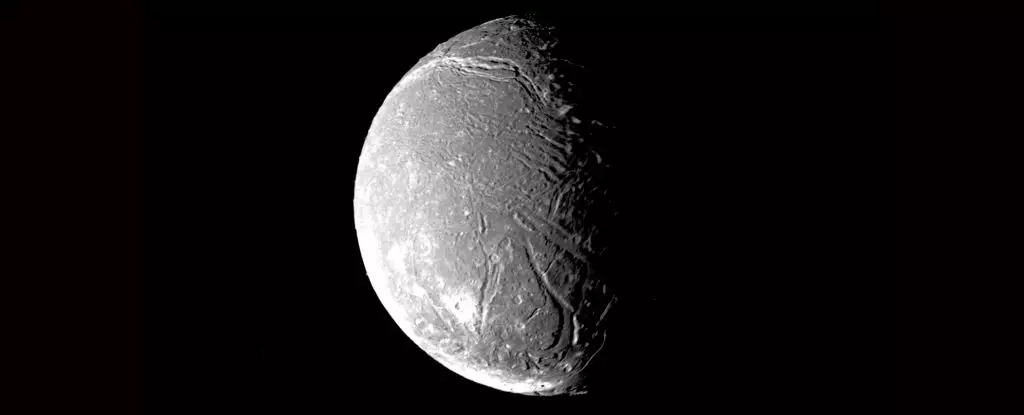The mysteries of our Solar System are vast, and among the most intriguing celestial objects we find are the moons of the gas giants—specifically the enigmatic moon Ariel, orbiting Uranus. Recent observations have illuminated the possibility that Ariel may harbor a hidden ocean beneath its icy crust, a finding that could reshape our understanding of its geological and potentially astrobiological features. Ariel’s surface, adorned with deep chasms, not only captures the imagination but also poses significant questions about its internal processes. Astronomers are eager to unlock the secrets of this distant world, but to do so, they must navigate through a myriad of complexities.
Directly impacted by its evolutionary history and interactions within the Uranian system, Ariel’s geologic activity is marked by striking surface features. Notably, the moon is characterized by extensive chasms that appear to be recent in their formation—likely shaped by dynamic internal forces. Studies suggest that these deep grooves could potentially serve as pathways for materials from lower layers of Ariel’s icy mantle to escape, hinting at significant geological processes at play.
Planetary geologist Chloe Beddingfield and her team at Johns Hopkins University Applied Physics Laboratory propose that these grooves may be the result of a spreading process akin to that occurring on Earth’s tectonic ridges. This theory posits that rising heat prompts the moon’s icy cover to crack, allowing materials from below to be deposited and reshaped over geological timescales. This connection to Earthly processes not only adds credibility to the findings but also ignites curiosity about what similar mechanisms could reveal about the internal structures of other celestial bodies.
The hypothesis of a subsurface ocean raises compelling questions about Ariel’s capacity to nurture life. With recent data from the James Webb Space Telescope hinting at the existence of liquid water beneath its icy façade, the possibility of an ocean on Ariel opens doors to astrobiological prospects that had previously been confined to more traditional suspects like Europa or Enceladus. The study of the carbon-bearing deposits found within the chasms may provide critical insight into the chemical interactions occurring in this hidden aquatic environment.
Interestingly, Ariel’s geologic history is intertwined with its orbital dynamics. The phenomenon known as orbital resonance, where the gravitational influence of nearby moons alters their paths, could play a crucial role in maintaining internal heat, thus facilitating the maintenance of an oceanic layer beneath the surface. The implications of such heat generation hint at a world far more complex than previously thought.
Despite the excitement surrounding Ariel’s potential ocean and geological dynamics, there remains a significant knowledge gap surrounding the distribution of surface ices. As Beddingfield notes, while carbon dioxide ice is present on the moon, the historical data from missions such as Voyager 2 do not allow for comprehensive mapping of these materials. The depth and characteristics of Ariel’s hypothesized ocean remain largely speculative due to these limitations. The inability to thoroughly understand the relationship between the grooves and surface ice presents a challenge for scientists aiming to unlock the full story of this moon.
The distinction between the observed surface features and the potential subsurface environment underscores the urgency for further exploration of the Uranian system. Both Ariel and its neighboring moons represent a frontier that is currently underexplored, despite their potential to contribute to our understanding of icy bodies in the Solar System.
With growing evidence of dynamic geological processes and the tantalizing hint of an ocean lurking beneath the surface, there is a significant call to action for space agencies around the world to prioritize missions to Uranus and its moons. The potential findings from such explorations could redefine our perspective on habitable environments beyond Earth and contribute valuable knowledge to planetary science.
As space exploration technology continues to advance, the curtain may soon be lifted on Ariel’s mysteries, providing not only insights into its unique geological makeup but also revealing whether it—like some of its fellow moons—could host conditions favorable to life. The journey to unveil these secrets is not just an academic pursuit; it is a quest that speaks to humanity’s drive to understand our place in the cosmos.
Ariel stands as a captivating subject for future research, with its geological surprises promising to enhance our understanding of icy worlds and the potential for life beyond Earth. As scientists dive deeper into the study of this moon, one thing remains clear: the need for exploration is pressing, and the time to act is now. The mysteries beneath Ariel’s icy crust beckon, waiting for eager minds and advanced technologies to crack their secrets wide open.


Leave a Reply